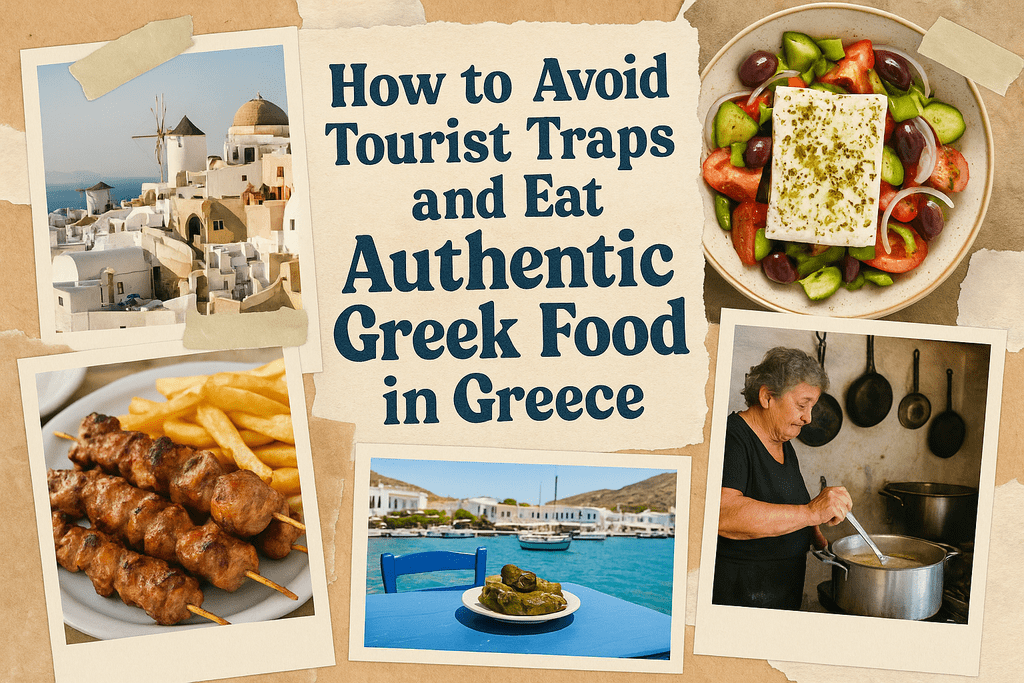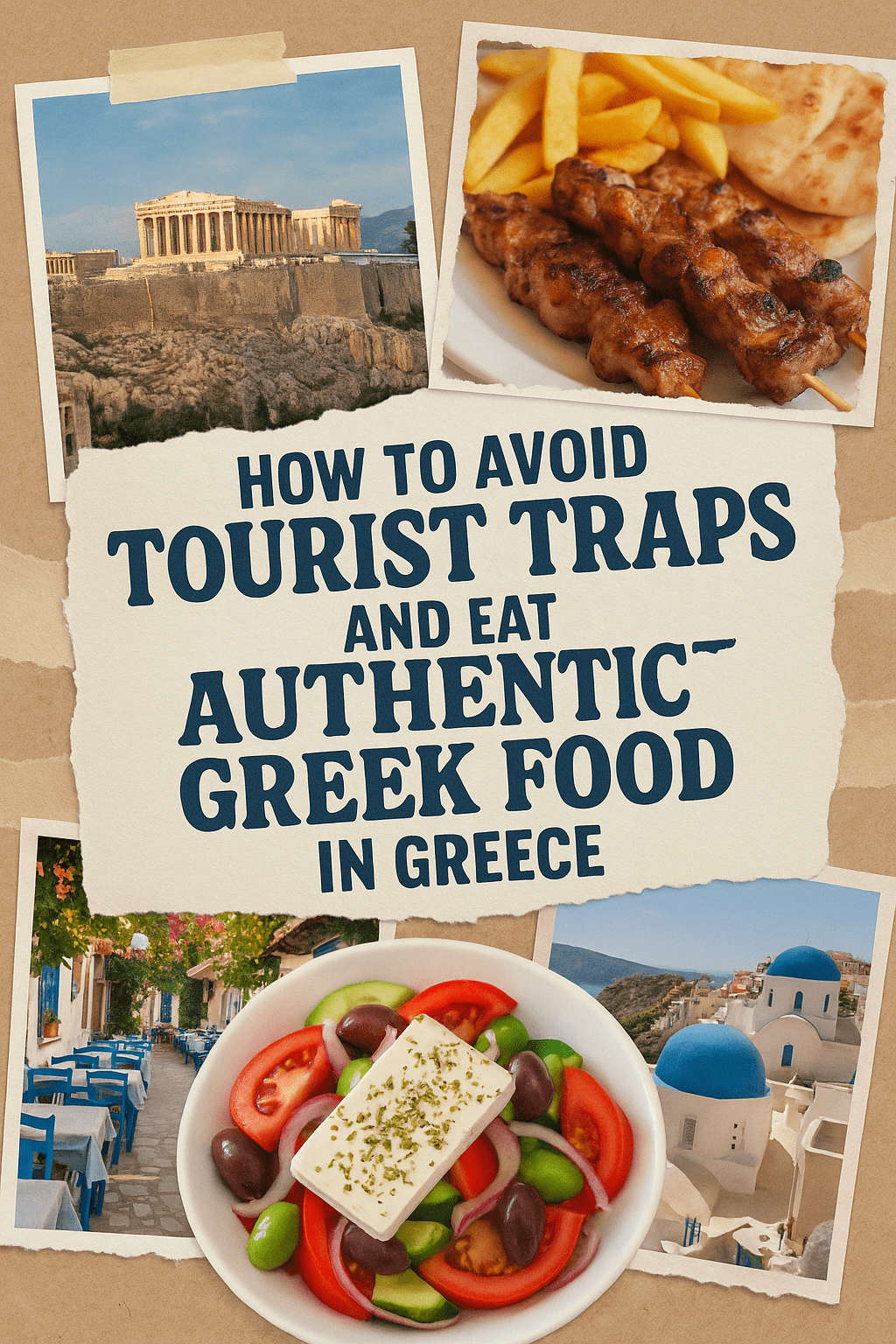How to Avoid Tourist Traps and Eat Authentic Greek Food in Greece
So you’re headed to Greece (jealous!) and dreaming about plates piled high with moussaka, grilled octopus, and feta-drenched salads, right? But hold up—before you fall into the nearest overpriced taverna waving photos of gyros like it’s Times Square, let’s talk strategy.
Eating like a local in Greece isn’t just possible—it’s essential. You don’t travel all that way for frozen souvlaki and microwaved baklava. You want the real stuff—grandma’s recipes, hidden seaside tavernas, and the kind of meals that make you cancel your flight home. Been there, done that, begged for the recipe.
Let’s dive (ugh, nope—let’s stroll) into how to dodge tourist traps and eat authentic Greek food like a seasoned pro. Or at least like someone who didn’t just Yelp “Greek food near me.”
1. Spotting a Tourist Trap From a Mile Away
Look, if a restaurant has a guy out front trying to lure you in like a carnival barker—run. That’s Greek for “we microwave the moussaka.”
🚩 Red Flags to Watch For:
-
Multilingual menus with flags next to each item (if it has five languages and still misspells tzatziki… hard pass).
-
Food photos on the menu that look like they were taken in 1997.
-
Servers pulling you in from the street like they’re offering a Black Friday deal.
-
Menus with pizza, burgers, AND Greek food. Pick a lane, please.
Authentic Greek tavernas don’t beg for business. They’re usually full of locals, and maybe even a little chaotic (in the best way).
A Quick Test:
Ask for the house wine. If they look confused, or bring you a bottle with a label, it’s a trap. The real deal comes in unmarked carafes, and yes—it’s often suspiciously strong. You’ve been warned.
2. Follow the Locals (No, Really—Literally Follow Them)
Ever notice how locals eat at 9 PM while tourists are wrapping up dessert at 7? That’s your first clue.
How to Find Local Hotspots:
-
Ask your Airbnb host or hotel receptionist where they eat (emphasis on they).
-
Stroll through a non-touristy neighborhood around lunchtime. Find the place packed with Greek families arguing over who gets the last dolma.
-
Look for places with handwritten menus or a chalkboard. These change daily because the ingredients are fresh, not because someone finally updated the clip art.
IMO, your best food discoveries happen by accident. One of my favorite meals in Athens was at a tiny hole-in-the-wall I found because I got lost. Worth the blister.
3. Learn the Essential Greek Dishes (and Pronounce Them Like You Mean It)
You don’t need to master the language, but knowing your spanakopita from your souvlaki helps.
Must-Try Authentic Greek Foods:
-
Moussaka – Think Greek lasagna, but with eggplant and bechamel.
-
Souvlaki – Skewered meat grilled to perfection. Chicken, pork, lamb—you can’t lose.
-
Kleftiko – Slow-roasted lamb that basically melts into your soul.
-
Gemista – Tomatoes and peppers stuffed with rice, herbs, and sometimes minced meat.
-
Fava – No, not fava beans. It’s actually a silky yellow split pea purée from Santorini.
-
Loukoumades – Donut holes’ sexier, honey-drizzled Greek cousin.
If you order a Greek salad and it shows up with lettuce, politely walk away. That ain’t it.
4. Taverna vs. Estiatorio: Yes, There’s a Difference
You’ll see two main types of sit-down places in Greece: tavernas and estiatorios. Here’s the deal:
Tavernas:
-
Casual, family-run
-
Limited menu (but everything is fresh)
-
Perfect for long lunches and even longer dinners
-
Probably has yiayia (grandma) cooking in the back
Estiatorios:
-
More formal
-
Often has a broader menu
-
Sometimes pricier (but not always better)
If the goal is authentic, lean tavernas. Especially the ones with plastic chairs, checkered tablecloths, and maybe a stray cat or two napping in the sun.
5. Don’t Skip the Street Food (Seriously, It’s a Whole Vibe)
You might think grabbing a bite from a street cart is sketchy. In Greece? It’s glorious.
Street Foods You’ll Crave Later:
-
Gyros – Pita stuffed with meat, fries, tomato, onion, and tzatziki. Yes, there are fries in it. Yes, it’s a national treasure.
-
Koulouri – Sesame-covered bread rings. Breakfast on the go.
-
Bougatsa – Custard or cheese-filled pastry. Best consumed at 3 AM after too much ouzo.
Pro tip: If you see locals lined up for a tiny window in the wall, join them immediately. They know what’s up.
6. Embrace the Greek Meze Lifestyle
Ordering just one dish? Rookie move. Greeks eat meze-style, which means small plates made for sharing.
Go Full Meze With:
-
Tzatziki, melitzanosalata (eggplant dip), taramasalata (fish roe spread)
-
Grilled octopus, fried zucchini, cheese pies
-
A cold beer or carafe of ouzo to get the conversation flowing
Meals in Greece are social. You linger, you talk, you laugh. It’s not about wolfing down your food. It’s about the experience.
7. Get Out of Athens (Yes, Really)
Look, Athens has some killer food spots—but Greece is so much more than the capital.
Where to Find Hidden Culinary Gems:
-
Pelion – Mountain villages with wood-fired stews and homemade cheese.
-
Naxos – An island famous for its potatoes, cheeses, and meats.
-
Thessaloniki – Greece’s second city has a vibrant street food scene and some of the best bougatsa ever.
Don’t just stick to the big tourist hubs. The smaller the village, the better the food—and the more likely you’ll meet someone’s grandma still stirring the pot.
8. Eat Seasonal (Because Greek Food is ALL About the Seasons)
You won’t find strawberries in November or artichokes in August—and that’s a good thing.
Seasonal Goodies to Look Out For:
-
Spring: Artichokes, wild greens, lamb dishes
-
Summer: Tomatoes, zucchini, fresh figs, watermelon with feta (don’t knock it)
-
Fall: Mushrooms, chestnuts, quince
-
Winter: Hearty soups, baked beans (gigantes), slow-cooked meats
Greek food tastes better because it follows nature’s rhythm. The tomatoes actually taste like tomatoes. Imagine that.
9. Learn a Few Greek Phrases (and Watch the Locals Light Up)
You don’t need to go full Duolingo, but throwing in a few Greek words can earn you major points.
Handy Phrases:
-
“Kalimera” – Good morning
-
“Efharistó” – Thank you
-
“Ti proteínete?” – What do you recommend?
-
“Einai spitikó?” – Is it homemade?
Just trying shows respect—and FYI, Greeks love it when you try. Even if you butcher the pronunciation. Badly.
10. Trust Your Gut (and Maybe Your Nose Too)
This might sound obvious, but if the food smells amazing and the place feels right—it probably is. Follow your instincts.
Some of my best meals came from following the scent of grilled meat or garlic down a quiet alley. One time in Crete, I ended up in a family’s backyard restaurant where they served me snails and homemade raki. I didn’t walk straight for two days. Worth it.
Final Bite: Eat Like You’re Greek (Because You’re Family Now)
Greece isn’t just about ticking off historical sites or catching that perfect sunset in Santorini. It’s about connecting—with people, with tradition, and yep, with your taste buds.
So skip the laminated menus. Avoid the all-you-can-eat buffet that promises “Greek Night” with mystery meat and bad Zorba music.
Instead, slow down. Ask questions. Order too much. Linger over lunch. Get a little lost. That’s how you find the real Greece—one delicious plate at a time.
And hey, if you end up falling in love with the food and trying to recreate it at home, just don’t use store-bought tzatziki. That’s where we draw the line.
Bon appétit—or as the Greeks say, Kali orexi! 🇬🇷










